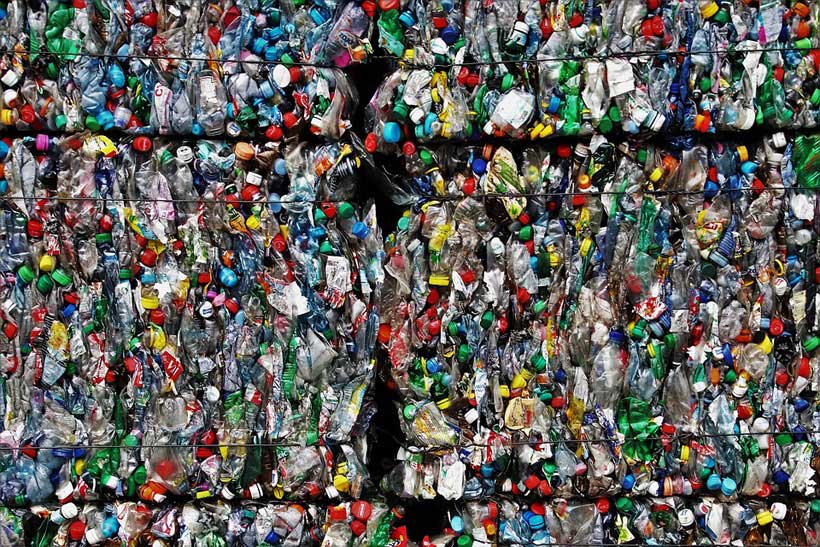BUSINESS & ECONOMY
Making Women Visible in Plastic Waste Management: Examples from Indonesia
Published
3 years agoon
By
Editor
Global plastic pollution is becoming increasingly severe. According to a report by the German weekly magazine ‘Focus‘, plastic particles have recently been found in samples collected all over the world, : from the Arctic to rivers and even deep seas.
Even Mount Everest, the top of the world, has been found to contain plastic particles. The United States has long accused developing countries of being the main responsible for plastic pollution. The waste approach has overshadowed the U.S. “major contribution” to the plastic pollution crisis. If we also consider the export of plastic waste and the latest statistics on illegal dumping and littering, the United States is one of the most severe sources of plastic pollution in the global coastal and marine environment, ranking third in the world.
The research report published by Science Advances clearly states that the United States blames Asian countries for the plastic waste pollution problem, although it is the world’s largest producer of plastic waste. The report was written in collaboration with scholars from the American Association for Marine Education, the University of Georgia and the National Geographic Association.
The Comprehensive Assessment Study on Global Plastic Waste Issues, published in 2015, stated that the top five countries producing most of the plastic waste are China, Indonesia, the Philippines, Vietnam and Thailand.
The latest report, however, finds that the 2015 study ignored any mismanagement of waste after it had been exported to another country for recycling.
The research report also revised the 2015 claim that China is the world’s largest emitter of marine plastic waste.
The latest research report published by Science Advances calculated the total amount of plastic waste generated by countries around the world in 2016, based on waste generation and characteristic data from 217 countries and regions reported by the World Bank.
Global plastic production in 2016 was 422 million tonnes, with a 26% increase as against 2010. The share of plastics in solid waste rose from 10% to 12% in 2010. In 2016, global plastic waste generation reached 242 million tonnes.
The report clearly states that in 2016 the United States was the country that produced the largest amount of plastic waste (42 million tonnes). It also ranked first in terms of annual per capita production of plastic waste (130 kilograms).
The 28 EU Member States ranking second produce 54.56 kilograms of plastic waste per capita per year, which is only half of the United States’ plastic waste, while India ranks third. In 2016 China ranked fourth in terms of plastic waste production (21.6 million tonnes), equivalent to half the U.S. amount, but its annual plastic waste production per capita was only 15.67 kilograms, equivalent to only 12% of the amount produced by the United States.
Nick Mallos, senior director of the Marine Conservation Organisation’s Garbage-Free Ocean Program, stated: “The plastic waste generated in the United States is the largest amount of any country, but we have been ignoring the problem, outsourcing it to developing countries. And we are making a heavy contribution to the plastic crisis in the oceans”.
In terms of rubbish, illegal dumping, littering and other improperly managed waste products on the coast, the United States ranks third among coastal countries and is the main cause of pollution in the world’s coastal areas.
The study also said that the United States collected 3.91 million tonnes of plastics in 2016, more than half of which was shipped overseas, and exported 1.99 million tonnes of plastic waste to 89 trading partners. “Over 88% of plastic waste is exported to countries that cannot properly manage and dispose of it due to insufficient resources.” Much of this exported plastic waste cannot be reused, which will eventually pollute the local environment.
One of the authors of the research report, oceanography professor Cara Lavender Law, stated: “For several years, many of the plastic products we throw in the rubbish can be exported to countries where it is already difficult to manage their own waste for recycling. Not to mention the large amount of plastics shipped from the United States. Considering the large amount of our plastic waste that is actually non-recyclable because it is of low value, contaminated or difficult to dispose of, it is not surprising that a lot of plastics will end up polluting the environment”.
Relevant data show that 5% of plastic waste generated in the United States is discarded or dumped illegally due to “improper handling and management” or cannot be disposed of properly after being transported to other countries.
The report underlines that it seems that only 5%is “improperly managed” but, considering the total amount of plastic waste, this figure cannot be ignored.
It should also be stated that eight million tonnes of plastics enter the oceans every year, which is equivalent to a plastic load being spilled into the sea every minute.
These plastic products have undertaken a long and destructive journey from the moment they have reached the sea. Winnie Liu, a senior official with The Pew Charitable Trust’s Marine Plastics Prevention Project, said: “Plastics reaching the seas will be carried far away by ocean currents. They are found all over the world, even on the edge of Antarctica and the deepest place on earth. Plastics can be found in the Mariana Trench. As they drift with currents, theywill penetrate the ecosystem and cause immeasurable damage to marine life”.
Despite the severity of this problem, global plastic production continues and is posing increasing threats to the seas. What makes the oceans so vulnerable to plastic pollution? How can we control the plastics entering the ocean? What is wrong with plastics?
In our daily lives we can hardly avoid plastics. From food packaging to toiletries, clothes, furniture, computers and cars, plastics is everywhere. Plastics durability makes it difficult to biodegrade them. In a way, it can be compared to long nuclear decay.
Depending on their type, some plastics can take decades or even millions of years to decompose in landfills. Therefore, unless plastics are incinerated (a process which, in turn, causes pollution), virtually all the plastics we have produced so far still exist in the world and, once entered the ocean, their impact will last for hundreds of years.
Where does waste come from? The world produces over 300 million tonnes of plastic waste every year, and this amount is still growing. Only 9% of this plastic waste is recycled. The rest is incinerated or discarded. Most of the discarded plastic waste is landfilled. The reason for this is that half of the plastics we produce is disposable plastics, i.e. plastic products such as straws, plastic bags and water bottles that are thrown away after they have been used.
It is precisely because disposable plastics are easy to produce and discard, and lead to a continuous increase in the amount of waste landfilled, that they inevitably increase the amount of plastic waste polluting the environment.
Why is the impact of plastics on the oceans so severe? The vast and deep oceans are like a retention tank for pollutants, which collects toxic material from all over the world. Besides the load dropped from ships, plastic fishing nets and longlines (known as ‘ghost fishing gear’) are also a major source of plastic waste in the oceans, accounting for about 10%. In addition, expanded polystyrene used in aquaculture to make cages is also a source of marine plastic pollution.
The vast majority of marine debris, however, comes from the land. Extreme weather conditions and strong winds sweep waste along the coast, which is quickly picked up by the tide. Oceans are also the final destination of thousands of rivers, carrying large amounts of waste from landfills, and eventually sinking it into the sea.
Once plastic waste enters the ocean, it is broken down into particles with a diameter of less than 5 mm, called microplastics. This happens because of the harsh conditions and endless ocean movements.
This form of plastics will spread ever deeper into the ocean. It will invade more biological habitats and cannot actually be recycled at all. What will happen to us if also thousands of marine animals get caught in plastic waste every year, especially ‘ghost fishing gear’? Furthermore, the harm to marine life from ingesting plastics is less evident: seabirds, sea turtles, fish and whales often mistake plastic waste for food because its colour and shape are similar to their preys. We end up eating them. Once we ingest these toxic particles, our organs will be damaged, thus making us more liable to diseases. Our fertility will also change, with great risks of genetic mutations.
Related
(function(d, s, id) { var js, fjs = d.getElementsByTagName(s)[0]; if (d.getElementById(id)) return; js = d.createElement(s); js.id = id; js.src = “//connect.facebook.net/en_US/sdk.js#xfbml=1&version=v2.4”; fjs.parentNode.insertBefore(js, fjs); }(document, ‘script’, ‘facebook-jssdk’));
Source
You may like
-


WEF and UN-Habitat Join Forces to Unlock Critical Investment in Cities through Public-Private Collaboration
-


5 ways countries can adapt to the climate crisis
-


The Development of Artificial Intelligence in China: Conclusions
-


Four ways the planetary crisis is impacting mental health
-


New European Bauhaus under Cohesion Policy: €50 million call for innovative projects in cities
-


The Development of Artificial Intelligence in China: Investment and attention to production
BUSINESS & ECONOMY
ICD and JSC Ziraat Bank Collaborate to Boost Uzbekistan’s Private Sector
Published
4 days agoon
May 16, 2024By
Editor
At the 3rd Tashkent Investment Forum, the Islamic Corporation for the Development of the Private Sector (ICD) and JSC Ziraat Bank Uzbekistan took a significant step forward in their partnership to empower small and medium-sized enterprises (SMEs) and foster economic growth in Uzbekistan. The forum, held in the capital city of Uzbekistan, brought together key stakeholders from the public and private sectors to discuss investment opportunities and economic development strategies for the region. The collaboration between the Islamic Corporation for the Development of the Private Sector (ICD) and JSC Ziraat Bank Uzbekistan is aimed at boosting the private sector in Uzbekistan.
During the forum, ICD and JSC Ziraat Bank Uzbekistan formalized an expression of intent to collaborate on various initiatives aimed at supporting SMEs. One of the key elements of this collaboration is the provision of a Line of Financing (LoF) facility by ICD to JSC Ziraat Bank Uzbekistan. This LoF facility will enable the bank to fund private sector projects as an agent of ICD, thereby providing SMEs with access to the necessary capital to initiate and grow their businesses.
The partnership between ICD and JSC Ziraat Bank Uzbekistan is expected to have a significant impact on the SME landscape in Uzbekistan. By equipping entrepreneurs with the resources they need to succeed, this collaboration will not only support the growth of individual businesses but also contribute to the overall economic development of the country. SMEs play a crucial role in driving economic growth, creating jobs, and fostering innovation, and this partnership will help strengthen the SME ecosystem in Uzbekistan.
JSC Ziraat Bank Uzbekistan, as a strategic partner for ICD, brings a wealth of experience and expertise to the table. As a prominent commercial bank with foreign capital, JSC Ziraat Bank Uzbekistan has a strong track record of supporting SMEs and promoting economic development. The bank’s partnership with ICD further underscores its commitment to advancing the private sector in Uzbekistan and its dedication to supporting the country’s economic growth.
ICD, for its part, is a leading multilateral development financial institution that focuses on supporting the economic development of its member countries through the provision of finance and advisory services to private sector enterprises. By partnering with JSC Ziraat Bank Uzbekistan, ICD is furthering its mission of promoting economic development and fostering entrepreneurship in Uzbekistan and across the Islamic world.
The LoF facility provided by ICD to JSC Ziraat Bank Uzbekistan is just one example of the many initiatives that the two entities are undertaking to support SMEs in Uzbekistan. In addition to providing financial support, the partnership between ICD and JSC Ziraat Bank Uzbekistan will also include capacity-building initiatives and technical assistance programs to help SMEs succeed in today’s competitive business environment.
Overall, the partnership between ICD and JSC Ziraat Bank Uzbekistan represents a significant step forward in supporting SMEs and fostering economic growth in Uzbekistan. By working together, these two institutions are helping to create a more vibrant and dynamic private sector in Uzbekistan, which will ultimately benefit the country’s economy and its people. The collaboration between the Islamic Corporation for the Development of the Private Sector (ICD) and JSC Ziraat Bank Uzbekistan is expected to have a far-reaching impact on the private sector in Uzbekistan.
BUSINESS & ECONOMY
In Times of Conflict, Spare a Thought for the Non-Gulf Economies
Published
2 weeks agoon
May 6, 2024By
Editor
By James Swanston
Positive news for non-GCC Arab economies has been in short supply of late. The Gaza conflict, missile attacks in the Red Sea, war in Ukraine and last month’s tit-for-tat missile strikes between Israel and Iran have weighed on sentiment, undermined limited confidence and cut into growth.
But some positives have emerged. Headline inflation rates have slowed across much of North Africa and the Levant, implying lower interest rates, a return to real growth and more stable exchange rates. March data show inflation at an annualised rate of just 0.9 percent in Morocco and 1.6 percent in Jordan. Tunisia’s inflation rate has also come down, although it is still running at over 7 percent year on year.
Egypt’s inflation rate jumped earlier this year as the government implemented price hikes to some goods and services – notably fuel. In February, the effect of the devaluation in the pound to the level of the parallel market affected prices. But March’s reading eased to an albeit still high 33 percent year on year.
Elsewhere, Lebanon’s inflation slowed to 70 percent year on year in March, the first time it has been in double – rather than triple – digits since early 2020 due to de-facto dollarisation and lower demand for imports. That said, inflation in these economies is vulnerable to increases in the prices of global foods and energy (such as oil) due to their being net importers. If supply chain disruptions persist, it could result in central banks keeping monetary policy tighter with consequences for growth and employment. And in Morocco’s case, it could undermine the Bank Al-Maghrib’s intention to widen the dirham’s trading band and formally adopt an inflation-targeting monetary framework.
The strikes by Iran and Israel undoubtedly marked a dangerous escalation in what up to now had been a proxy war. Thankfully, policymakers across the globe have for the moment worked to de-escalate the situation. Outside the countries directly involved, the most significant spillover has been the disruptions to shipping in the Red Sea and Suez Canal. Many of the major global shipping companies have diverted ships away from the Red Sea due to attacks by Houthi rebels and have instead opted to go around the Cape of Good Hope.
The latest data shows that total freight traffic through the Suez Canal and Bab el-Mandeb Strait is down 60-75 percent since the onset of the hostilities in Gaza in early October. Almost all countries have seen fewer port calls. This could create fresh shortages of some goods imports, hamper production, and put upward pressure on prices.
For Egypt, inflation aside, the shipping disruptions have proven to be a major economic headache. Receipts from the Suez Canal were worth around 2.5 percent of GDP in 2023 – and that was before canal fees were hiked by 15 percent this January. Canal receipts are a major source of hard currency for Egypt and officials have said that revenues are down 40-50 percent compared to levels in early October.
The conflict is also weighing on the crucial tourism sector. Tourism accounts for 5-10 percent of GDP in the economies of North Africa and the Levant and is a critical source of hard currency inflows.
Jordan, where figures are the timeliest, show that tourist arrivals were down over 10 percent year on year between November and January. News of Iranian drones and missiles flying over Jordan imply that these numbers will, unfortunately, have fallen further.
In the case of Egypt, foreign currency revenues – from tourism and the Suez canal – represent more than 6 percent of GDP and are vulnerable. This played a large part in the decision to de-value the pound and hike interest rates aggressively in March.
The saving grace is that the conflict has galvanised geopolitical support for these economies. For Egypt, the aforementioned policy shift was accompanied by an enhanced $8bn IMF deal and, while not strictly bilateral support, the bumper Ras el-Hekma deal seems to have been accelerated as the pressure on the Egyptian economy ratcheted up. This is providing much needed foreign currency. At the same time, Jordan recently renewed its financing arrangement with the IMF for $1.2bn over four years.
Tunisia, however, is an exception. President Saied’s anti-IMF rhetoric and reluctance to pass reforms, such as harsh fiscal consolidation, in an election year, mean that the country’s staff-level agreement for an IMF deal is likely to remain in limbo. If strains on Tunisia’s foreign receipts are stretched, and the central bank and government continue with unorthodox policies of deficit financing, there is a risk that Tunisia’s economic crisis will become messier more quickly in the next year – particularly large sovereign debt repayments are due in early 2025.
James Swanston is Middle East and North Africa economist at London-based Capital Economics
BUSINESS & ECONOMY
Debt Dependency in Africa: the Drivers
Published
2 weeks agoon
May 6, 2024By
Editor
In mid-April Ghana’s efforts to restructure its sovereign debt came to nothing, increasing the risk that it couldn’t keep up with its repayments. This is a familiar story for many African countries. Twenty of them are in serious debt trouble. Carlos Lopes argues that there are three factors driving this state of affairs: the rules of the international banking system; lenders’ focus on poverty reduction rather than development needs; and unfair treatment by rating agencies.
The debt situation in many African countries has escalated again to a critical juncture. Twenty are in, or at risk of, debt distress. Three pivotal elements significantly contribute to this. Firstly, the rules governing the international banking system favour developed countries and work against the interests of African countries.
Secondly, multilateral financial institutions such as the International Monetary Fund (IMF) and the World Bank focus on poverty alleviation. This is commendable. But it doesn’t address the liquidity crisis countries face. Many don’t have the necessary readily available funds in their coffers to cover urgent development priorities due to their dependency on volatile commodity exports. As a result governments turn to raising sovereign debt under conditions that are among the most unfavourable on the planet. This perpetuates a debt dependency cycle rather than fostering sustainable economic growth.
Thirdly, there’s the significant influence of biased credit rating agencies. These unfairly penalise African countries. In turn, this impedes their ability to attract investment on favourable terms. The convergence of these three factors underscores the imperative to implement effective strategies aimed at mitigating the overwhelming debt burden afflicting African nations. These strategies must address the immediate financial challenges facing countries. They must also lay the groundwork for long-term economic sustainability and equitable development across the continent.
By tackling these issues head-on, a financial environment can be created that fosters growth, empowers local economies, and ensures that African countries have access to the resources they need to thrive.
Rules of the banking game
The Bank for International Settlements is often called the “central bank for central banks”. It sets the regulations and standards for the global banking system. But its rules disproportionately favour developed economies, leading to unfavourable conditions for African countries. For instance, capital adequacy requirements – the amount of money banks must hold in relation to their assets – and other prudential rules may be disproportionately stringent for African markets. This limits lending to stimulate economic growth in less attractive economies.
The bank’s policies also often overlook developing nations’ unique challenges. Following the 2008/2009 financial crisis, the bank introduced a new, tougher set of regulations. Their complexity and stringent requirements have inadvertently accelerated the withdrawal of international banks from Africa.
They have also made it increasingly difficult for global banks to operate profitably in African markets. As a result, many have chosen to scale back their operations, or exit. The withdrawals have reduced competition within the banking sector, limited access to credit for businesses and individuals, and hampered efforts to promote economic growth and development.
The limitations of the new regulations highlight the need for a more nuanced approach to banking regulation. The adverse effects could be mitigated by simplifying the regulations. For example, requirements could be tailored to the specific needs of African economies, and supporting local banks.
Focus on poverty alleviation
Multilateral financial institutions like the IMF and the World Bank play a crucial role in providing financial assistance to many countries on the continent. But their emphasis on poverty alleviation and, more recently, climate finance often overlooks the urgent spending needs. Additionally, the liquidity squeeze facing countries further limits their capacity to prioritise essential expenditure. Wealthy nations enjoy the luxury of lenient regulatory frameworks and ample fiscal space. For their part African countries are left to fend for themselves in an environment rife with predatory lending practices and exploitative economic policies. Among these are sweetheart tax deals which often involving tax exemptions. In addition, illicit financial practices by multinational corporations drain countries of their limited resources. Research by The ONE Campaign found that financial transfers to developing nations plummeted from a peak of US$225 billion in 2014 to just US$51 billion in 2022, the latest year for which data is available. These flows are projected to diminish further.
Alarmingly, the ONE Campaign report stated that more than one in five emerging markets and developing countries allocated more resources to debt servicing in 2022 than they received in external financing. Aid donors have been touting record global aid figures. But nearly one in five aid dollars was directed towards domestic spending hosting migrants or supporting Ukraine. Aid to Africa has stagnated.
This leaves African countries looking for any opportunities to access liquidity, which makes them a prey of debt scavengers. As noted by Columbia University professor José Antonio Ocampo, the Paris Club, the oldest debt-restructuring mechanism still in operation, exclusively addresses sovereign debt owed to its 22 members, primarily OECD countries.
With these limited attempts to address a significant structural problem of pervasive indebtedness it is unfair to stigmatise Africa as if it contracted debt because of its performance or bad management.
Rating agencies
Rating agencies wield significant influence in the global financial landscape. They shape investor sentiment and determine countries’ borrowing costs. However, their assessments are often marked by bias. This is particularly evident in their treatment of African countries. African nations argue that without bias, they should receive higher ratings and lower borrowing costs. In turn this would mean brighter economic prospects as there is a positive correlation between financial development and credit ratings. However, the subjective nature of the assessment system inflates the perception of investment risk in Africa beyond the actual risk of default. This increases the cost of credit.
Some countries have contested ratings. For instance, Zambia rejected Moody’s downgrade in 2015, Namibia appealed a junk status downgrade in 2017 and Tanzania appealed against inaccurate ratings in 2018. Ghana contested ratings by Fitch and Moody’s in 2022, arguing they did not reflect the country’s risk factors. Nigeria and Kenya rejected Moody’s rating downgrades. Both cited a lack of understanding of the domestic environment by rating agencies. They asserted that their fiscal situations and debt were less dire than estimated by Moody’s.
Recent arguments from the Economic Commission for Africa and the African Peer Review Mechanism highlight deteriorating sovereign credit ratings in Africa despite some posting growth patterns above 5% for sustained periods. Their joint report identifies challenges during the rating agencies’ reviews. This includes errors in publishing ratings and commentaries and the location of analysts outside Africa to circumvent regulatory compliance, fees and tax obligations.
A recent UNDP report illuminates a staggering reality: African nations would gain a significant boost in sovereign credit financing if credit ratings were grounded more in economic fundamentals and less in subjective assessments. According to the report’s findings, African countries could access an additional US$31 billion in new financing while saving nearly US$14.2 billion in total interest costs.
These figures might seem modest in the eyes of large investment firms. But they hold immense significance for African economies. If credit ratings accurately reflected economic realities, the 13 countries studied could unlock an extra US$45 billion in funds. This is equivalent to the entire net official development assistance received by sub-Saharan Africa in 2021. These figures underscore the urgent need to address the systemic biases plaguing credit rating assessments in Africa.
Next steps
Debates about Africa’s debt crisis often lean towards solutions centered on compensation. These advocate for increased official development aid, more generous climate finance measures, or the reduction of borrowing costs through hybrid arrangements backed by international financial systems. These measures may offer temporary relief. But they need to be more genuine solutions in light of the three structural challenges facing African countries.
Carlos Lopes,a Professor at the Nelson Mandela School of Public Governance, University of Cape Town, is the Chair of the African Climate Foundation’s Advisory Council as well as its Chairman of the Board. He is also a board member of the World Resources Institute and Climate Works Foundation.
Courtesy: The Conversation

Red Notice: Putin is Nearby

We are not Yet Winning, but they are Losing

HLISB Introduces BizHalal To Support SMEs in the Global Halal Market
Topics
- AGRIBUSINESS & AGRICULTURE
- BUSINESS & ECONOMY
- DIGITAL ECONOMY & TECHNOLOGY
- EDITORIAL
- ENERGY
- EVENTS & ANNOUNCEMENTS
- HALAL ECONOMY
- HEALTH & EDUCATION
- IN CASE YOU MISSED IT
- INTERNATIONAL POLITICS
- ISLAMIC FINANCE & CAPITAL MARKETS
- KNOWLEDGE CENTRE, CULTURE & INTERVIEWS
- OBITUARY
- OPINION
- PROFILE
- PUBLICATIONS
- SPECIAL FEATURES/ECONOMIC FOOTPRINTS
- SPECIAL REPORTS
- SUSTAINABILITY & CLIMATE CHANGE
- THIS WEEK'S TOP STORIES
- TRENDING
- UNCATEGORIZED
- UNITED NATIONS SDGS
Trending
-

 TRENDING12 months ago
TRENDING12 months agoAFRIEF Congratulates New Zamfara State Governor
-

 PROFILE9 months ago
PROFILE9 months agoA Salutary Tribute to General Ibrahim Badamasi Babangida: Architect of Islamic Finance in Nigeria
-

 BUSINESS & ECONOMY3 years ago
BUSINESS & ECONOMY3 years agoClimate Policy In Indonesia: An Unending Progress For The Future Generation
-

 BUSINESS & ECONOMY3 years ago
BUSINESS & ECONOMY3 years agoThe Climate Crisis is Now ‘Code Red’: We Can’t Afford to Wait Any Longer
-

 HALAL ECONOMY10 months ago
HALAL ECONOMY10 months agoRevolutionizing Halal Education Through Technology
-

 BUSINESS & ECONOMY3 years ago
BUSINESS & ECONOMY3 years agoIPCC report: ‘Code red’ for human driven global heating
-

 SPECIAL REPORTS5 months ago
SPECIAL REPORTS5 months agoRemembering Maryam Ibrahim Babangida: A Legacy of Grace, Philanthropy, and Leadership
-

 BUSINESS & ECONOMY3 years ago
BUSINESS & ECONOMY3 years agoDistributed Infrastructure: A Solution to Africa’s Urbanization

